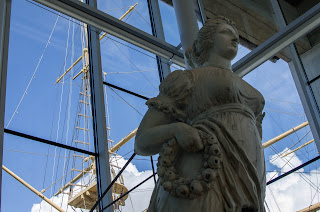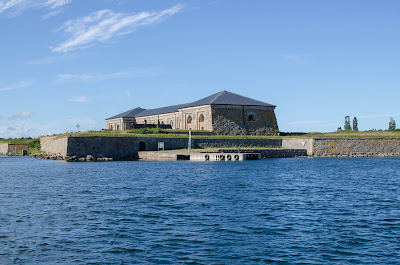For anybody interested in naval history, and ships in general, a visit to the Swedish Naval port of Karlskrona is highly recommended. The UNESCO World Heritage list description is a good introduction to the history of this unique naval center:
The naval port of Karlskrona was founded in 1680, at a time when Sweden was a major power whose territory included modern Finland, Estonia, Latvia, and parts of north Germany. The first step towards domination of the Baltic came when Sweden secured direct access to the North Sea ports and broke Danish control over Öresund Sound, the key to Baltic trade. When peace with Denmark was declared in 1658 with the Treaty of Roskilde, Skåne, Blekinge, and Gotland became Swedish territory.
A garrison and shipyard were installed at the small port of Bodekull, renamed Karlshamn in honour of King Karl XI. However, after a short Danish occupation (1676-79), it was recognized that this was not the ideal site for a naval base, and so in 1680 Karl XI issued a charter for the foundation of a new town in the east of Blekinge on the islands of Wämö and Trossö, to be known as Karlskrona and to serve both as a port and as a naval base. Tradesmen and merchants from this hitherto Danish area were forced into the new town by the withdrawal of their charters from the established towns of Kristianopel and Ronneby, and the region was progressively assimilated into Sweden.
The naval installations that developed at Karlskrona, beginning with a shipyard and storage facilities, were initially supervised by Erik Dahlbergh, Quartermaster General, responsible for the defences of the Swedish kingdom. Naval architects and craftsmen were sent from Stockholm, and houses were built to receive them. The shipyard began with two building berths, two quays, two forges, and five warehouses; the first keel was laid down in December 1680 and the first ship was launched the following year.
Karlskrona became a seat of government in 1683, the year in which Dahlbergh drew up the definitive plans for the town and its fortifications. By the time Gustav III took the throne by means of a coup d'état in 1772 it had become the third largest town in Sweden. There was a frenzied burst of activity at this time, with the building of a large fleet (accompanied by renewed building activity in the town itself) aimed first at Denmark and then Russia. Gustav's military adventures achieved very little, and he was assassinated by his political enemies among the nobility, who resented his assumption of absolute power. The loss of Finland in 1809 saw the end of the Swedish imperial dream.
Despite the political decline of the country, Karlskrona continued as the main base for the Swedish navy. A number of modernization and expansion projects took place during the 19th and 20th centuries, to keep pace with developments in naval and military tactics and technology (although the shipyard was slow to adopt new technologies, with the result that wooden hulls did not give way to steel until the 1880s). World War II saw the modernization of some of the older fortifications and the installation of new facilities for defence against aerial attack. Since that time there has been a progressive diminution of activity in the naval area, though it still plays an active role in the Swedish defence system. The town has been damaged by fire, most severely in 1790. As a result, rebuilding of the destroyed buildings, numbering over 400, was carried out using stone. However, the original street layout was largely preserved.
 |
| The naval harbour is a fascinating mix of historic buildings and contemporary marine technology. |
 |
| Many of the historic naval shipyard buildings are architectural masterpieces. |
 |
| Old and new side by side. |
 |
| The Royal Swedish Navy's Corvette Harnosand K33 (launched in 2004) is probably in for service or refitting. |
 |
| The corvette K12 Malmo was launched already in 1986. |
 |
| One of the Royal Swedish Navy's high speed boats on its way to the Karlskrona archipelago. |
 |
| If you are not able to board one of the navy ships, you can visit the nearby fortress islands on board the Blekinge, the oldest Swedish passenger ship still in service. |
 |
| At some stage the commander of the fortress wanted a more comfortable place to live in when on duty. The navy built this nice red cottage for him. |
 |
| The main entrance seen through the bell "tower". |
 |
| Part of the facade facing the sea. |
 |
| The main walls are about five meters thick. |
 |
| The Kungsholmen fortress was built to protect the eastern side of the fairway. It is still partially used by the Navy. |
 |
| The fully rigged navy training ship Jarramas was the last tall ship built at the Karlskrona navy shipyard. |
 |
| The Jarramas is now one of the attractions at the excellent Naval Museum. |
 |
| The retired missile boat Västervik R136 is also on display at the Naval Museum. |
 |
| The Naval Museum has a fine Collection of figureheads. |
 |
| Some of the museum collections are housed in these buildings. |
 |
| A collection of traditional wooden boats at the Naval Museum. |
 |
| The magnificnt Admiralty Church, built in 1685, is the largest wooden church in Sweden. It was supposed to be a temporary building, but its replacement was never built. |
 |
| The Admiralty Church seen from the sea. |
 |
| Gilbert Sheldon was a prominent shipbuilder of British descent, who worked in Karlskrona. His grandfather emigrated to Sweden in 1655. |
 |
| Historic naval architecture on one of the islands. |
 |
| The Swedish Coast Guard offices. |
 |
| The Palace-like residence of the Governor of Blekinge county (center left). |
 |
| A closer look at the Governor's Residence. |
 |
| Historic waterfront buildings in central Karlskrona. |
 |
| Many of the modern buildings mix well with the old houses. |
 |
| A detail of the German Church. |
 |
| A view of the main naval Island, Trossö. |
 |
| One of the bridges connecting two of the main islands. |
 |
| The shipyard workers lived in small huts in the direct vicinity of the naval shipyard. The picturesque wooden houses are well taken care of by their contemporary owners. |
 |
| Window flowers in one of the wooden huts. |
 |
| A row of colorful huts. |
 |
| The decorative entrance to a former workers' hut. |




No comments:
Post a Comment